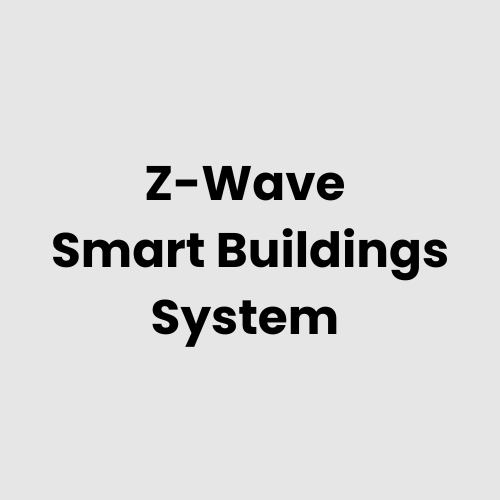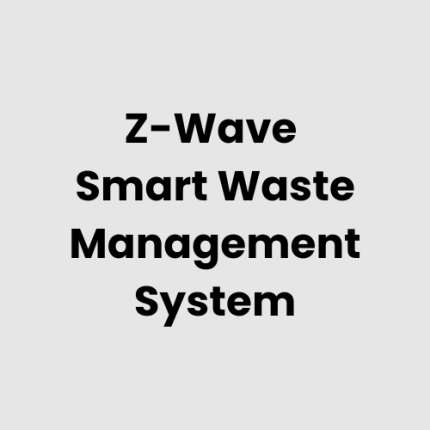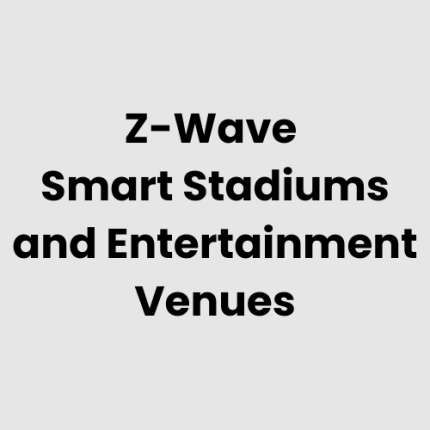Description
Z-Wave Enabled Smart Buildings System
Technical Architecture of Z-Wave Enabled Smart Buildings System
The architecture of Z-Wave Enabled Smart Buildings is structured to optimize interoperability and scalability. It consists of:
- Z-Wave Controllers: Central hubs that manage communication between devices.
- Edge Nodes: Sensors, actuators, and other endpoints interacting directly with the physical environment.
- Mesh Network Topology: Ensures resilient communication by routing signals through multiple devices.
- Gateway Interface: Facilitates integration with external systems like cloud platforms or local servers.
- Security Layer: Implements encryption and authentication protocols for secure data transmission.
List of Hardware for Z-Wave Enabled Smart Buildings System
- Z-Wave Hubs: Central management units.
- Smart Thermostats: For climate control.
- Smart Lighting Systems: Dimmable and automated lighting modules.
- Motion and Occupancy Sensors: To enhance security and energy efficiency.
- Smart Locks and Access Control Systems: For secure entry management.
- Energy Monitoring Devices: To track and optimize power usage.
- Connected Appliances: Including HVAC systems and entertainment devices.
- Repeaters and Extenders: To strengthen the mesh network coverage.
Physical Placement Considerations
- Hubs and Gateways: Should be centrally located for optimal connectivity.
- Sensors: Position in high-traffic areas or zones needing monitoring, such as entryways or meeting rooms.
- Lighting Modules: Installed in strategic lighting fixtures to control ambient settings.
- Repeaters: Deployed in larger buildings to maintain network robustness.
- Security Devices: Mounted at entry points and sensitive areas for maximum effectiveness.
Hardware Architecture of Z-Wave Enabled Smart Buildings System
The hardware architecture includes:
- Core Processing Units: Embedded in hubs for data aggregation and processing.
- Z-Wave Radios: Integrated in devices for communication within the network.
- Power Modules: Battery or mains-powered options depending on the device type.
- Interfaces: Mobile apps or control panels for user interaction.
Deployment Considerations
- Pre-Deployment Assessment: Evaluate building layout, existing systems, and connectivity needs.
- Network Design: Create a detailed map of device placements to optimize mesh performance.
- Scalability: Ensure the system can accommodate additional devices without performance degradation.
- Compliance: Adhere to relevant industry standards for safety and interoperability.
- Testing and Validation: Perform rigorous system tests before going live.
List of Relevant Industry Standards and Regulations
- ANSI/ASHRAE Standards
- FCC Part 15 Regulations
- ISO/IEC 14543 (Z-Wave specifications)
- UL 294 (Access control systems)
- IEC 62368-1 (Safety for AV and IT equipment)
Local Server Version
The local server version of Z-Wave Enabled Smart Buildings offers:
- Onsite Data Processing: Reduces latency for real-time operations.
- Enhanced Privacy: Keeps sensitive data within the premises.
- Offline Functionality: Ensures critical functions remain operational without internet access.
- Seamless Integration: Works with existing building management systems.
GAO Tek Inc. provides robust local server setups tailored to unique building requirements, ensuring high reliability and security.
Cloud Integration and Data Management
Z-Wave Enabled Smart Buildings can leverage cloud platforms for:
- Centralized Management: Monitor and control multiple buildings remotely.
- Advanced Analytics: Harness cloud-based AI to analyze energy consumption, security trends, and occupancy patterns.
- Scalable Storage: Archive historical data for compliance and strategic planning.
- Automatic Updates: Ensure devices run the latest firmware for improved performance.
At GAO Tek, we facilitate seamless cloud integration while prioritizing data security and compliance with global standards.
GAO Case Studies
- Atlanta, Georgia
A commercial building in Atlanta was transformed into a Z-Wave-enabled smart facility, incorporating advanced lighting control and energy monitoring systems. This project significantly reduced energy costs and improved operational efficiency. GAO Tek played a key role in integrating reliable Z-Wave devices into the building’s legacy systems. - New York City, New York
In NYC, a mixed-use building implemented Z-Wave technology for climate control and automated security. The installation of motion sensors and smart thermostats allowed efficient energy use and enhanced tenant comfort. GAO Tek ensured compliance with stringent building codes and provided ongoing support. - San Francisco, California
A large office complex in San Francisco used Z-Wave smart devices to optimize lighting schedules and HVAC operations. The project emphasized sustainability, reducing the building’s carbon footprint. GAO Tek facilitated the seamless integration of these devices with an existing building management platform. - Chicago, Illinois
A residential high-rise in Chicago adopted Z-Wave solutions for smart locks, occupancy monitoring, and connected lighting. This system improved tenant security and allowed for convenient, remote management of common areas. GAO Tek’s expertise ensured rapid deployment with minimal disruption. - Houston, Texas
In Houston, a healthcare facility integrated Z-Wave technology to manage energy-efficient lighting and real-time environmental monitoring. GAO Tek provided tailored solutions to meet the specific needs of the healthcare environment, ensuring a secure and reliable system. - Denver, Colorado
A corporate campus in Denver utilized Z-Wave technology to create a cohesive smart building network, focusing on automated shading systems and indoor air quality monitoring. GAO Tek’s robust implementation enhanced both employee comfort and energy savings. - Seattle, Washington
A hospitality chain in Seattle deployed Z-Wave-enabled smart locks and environmental controls to improve guest experiences. The system enabled seamless integration with the chain’s existing IT infrastructure. GAO Tek supported this initiative with expertise in hospitality-focused IoT solutions. - Orlando, Florida
An Orlando-based theme park adopted Z-Wave-enabled building controls for centralized lighting and energy management across its administrative offices. GAO Tek ensured scalability, enabling future expansions without compromising system performance. - Boston, Massachusetts
A university in Boston incorporated Z-Wave systems for smart lighting and room scheduling in its new academic buildings. This solution supported sustainability goals and enhanced resource management. GAO Tek provided extensive training for staff to maximize system benefits. - Phoenix, Arizona
A Phoenix municipal building deployed Z-Wave technology to improve water management and automated lighting. This initiative resulted in significant cost savings and improved environmental compliance, with GAO Tek guiding every step of the integration. - Las Vegas, Nevada
A luxury hotel in Las Vegas implemented Z-Wave smart systems for guest room climate and lighting control. GAO Tek delivered tailored solutions that aligned with the hotel’s premium service standards and energy efficiency goals. - Miami, Florida
In Miami, a corporate headquarters used Z-Wave-enabled sensors and actuators to automate HVAC controls. The technology provided significant energy savings during peak operating hours. GAO Tek supported the project with precise device configuration and testing. - Dallas, Texas
A retail center in Dallas adopted Z-Wave solutions for security and occupancy-based lighting. This improved the safety and customer experience while optimizing operational costs. GAO Tek offered end-to-end implementation support. - Portland, Oregon
A manufacturing facility in Portland utilized Z-Wave-enabled energy monitors to track and optimize power usage across production lines. GAO Tek’s industry-specific expertise ensured a seamless deployment tailored to the manufacturing environment. - Charlotte, North Carolina
An office building in Charlotte integrated Z-Wave technology for automated blinds and climate control. These upgrades provided substantial energy savings and enhanced tenant satisfaction. GAO Tek worked closely with facility managers to ensure smooth implementation.
Canada
- Toronto, Ontario
A condominium complex in Toronto deployed Z-Wave-enabled systems for security and energy management. The project improved resident safety and reduced utility costs. GAO Tek’s headquarters in Toronto provided onsite support and customized solutions for the unique requirements of the property. - Vancouver, British Columbia
A mixed-use building in Vancouver implemented Z-Wave technology for lighting automation and environmental monitoring. The system helped the property achieve a green building certification. GAO Tek provided expert guidance to meet regulatory standards and optimize performance.
Navigation Menu for Z-Wave
- Z- Wave Gateways/Hubs
- Z-Wave End Devices
- Z-Wave-Cloud, Server, PC& Mobile System
- Z-Wave Accessories
- Z-Wave Resources
Navigation Menu for IoT
Our products are in stock and can be shipped anywhere in the continental U.S. or Canada from our local warehouse. For any further information, please fill out this form or email us.
We are actively looking for partners who are like us located in the U.S. and Canada. For more information on partnering with GAO, please visit Partner with GAO Tek Inc. It lists various ways to partner with GAO, such as OEM Partnerships, Technology Integration, Distribution and Reselling Opportunities, Presenting at the Leading Event Tek Summit, Joint R&D Projects, Training and Consulting Services, Industry-Specific Collaborations, Research and Academic Partnerships.



